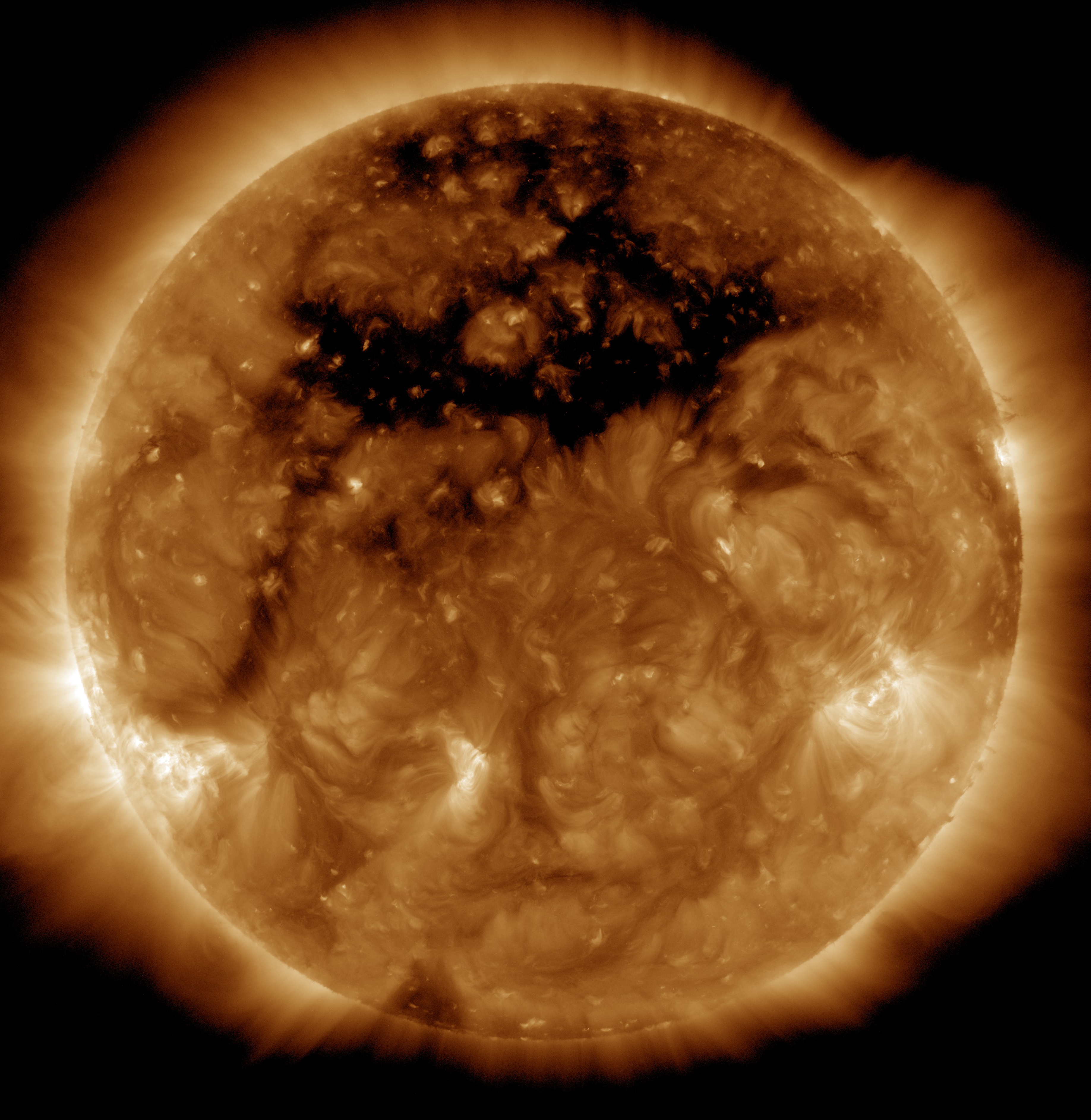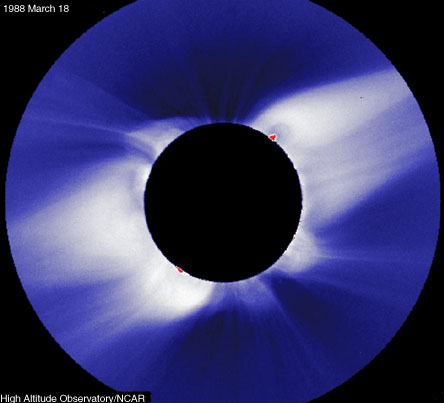coronal holes on:
[Wikipedia]
[Google]
[Amazon]
 Coronal holes are regions of the Sun's corona that emit low levels of
Coronal holes are regions of the Sun's corona that emit low levels of
 Coronal holes were first observed during total solar eclipses. They appeared as dark regions surrounded by much brighter helmet streamers above the Sun's limb.
In the 1960s, coronal holes appeared in X-ray images taken by
Coronal holes were first observed during total solar eclipses. They appeared as dark regions surrounded by much brighter helmet streamers above the Sun's limb.
In the 1960s, coronal holes appeared in X-ray images taken by
 Coronal hole size and population correspond with the
Coronal hole size and population correspond with the
 Coronal holes are regions of the Sun's corona that emit low levels of
Coronal holes are regions of the Sun's corona that emit low levels of ultraviolet
Ultraviolet radiation, also known as simply UV, is electromagnetic radiation of wavelengths of 10–400 nanometers, shorter than that of visible light, but longer than X-rays. UV radiation is present in sunlight and constitutes about 10% of ...
and X-ray radiation compared to their surroundings. They are composed of relatively cool and tenuous plasma permeated by magnetic field
A magnetic field (sometimes called B-field) is a physical field that describes the magnetic influence on moving electric charges, electric currents, and magnetic materials. A moving charge in a magnetic field experiences a force perpendicular ...
s that are open to interplanetary space.Freedman, Roger A., and William J. Kaufmann III. "Our Star, the Sun." Universe. 8th ed. New York: W.H. Freeman, 2008. 419–420. Print. Compared to the corona's usual closed magnetic field that arches between regions of opposite magnetic polarity, the open magnetic field of a coronal hole allows solar wind
The solar wind is a stream of charged particles released from the Sun's outermost atmospheric layer, the Stellar corona, corona. This Plasma (physics), plasma mostly consists of electrons, protons and alpha particles with kinetic energy betwee ...
to escape into space at a much quicker rate. This results in decreased temperature and density of the plasma at the site of a coronal hole, as well as an increased speed in the average solar wind measured in interplanetary space.
Streams of fast solar wind originating from coronal holes can interact with slow solar wind streams to produce corotating interaction regions. These regions can interact with Earth's magnetosphere
In astronomy and planetary science, a magnetosphere is a region of space surrounding an astronomical object in which charged particles are affected by that object's magnetic field. It is created by a celestial body with an active interior Dynamo ...
to produce geomagnetic storm
A geomagnetic storm, also known as a magnetic storm, is a temporary disturbance of the Earth's magnetosphere that is driven by interactions between the magnetosphere and large-scale transient Plasma (physics), plasma and magnetic field structur ...
s of minor to moderate intensity. During solar minima, CIRs are the main cause of geomagnetic storms.
History
 Coronal holes were first observed during total solar eclipses. They appeared as dark regions surrounded by much brighter helmet streamers above the Sun's limb.
In the 1960s, coronal holes appeared in X-ray images taken by
Coronal holes were first observed during total solar eclipses. They appeared as dark regions surrounded by much brighter helmet streamers above the Sun's limb.
In the 1960s, coronal holes appeared in X-ray images taken by sounding rockets
A sounding rocket or rocketsonde, sometimes called a research rocket or a suborbital rocket, is an instrument-carrying rocket designed to take measurements and perform scientific experiments during its sub-orbital spaceflight, sub-orbital flight ...
and in observations at radio wavelengths by the Sydney Chris Cross radio telescope. At the time, what they were was unclear. Their true nature was recognized in the 1970s, when X-ray
An X-ray (also known in many languages as Röntgen radiation) is a form of high-energy electromagnetic radiation with a wavelength shorter than those of ultraviolet rays and longer than those of gamma rays. Roughly, X-rays have a wavelength ran ...
telescopes
A telescope is a device used to observe distant objects by their emission, Absorption (electromagnetic radiation), absorption, or Reflection (physics), reflection of electromagnetic radiation. Originally, it was an optical instrument using len ...
in the Skylab
Skylab was the United States' first space station, launched by NASA, occupied for about 24 weeks between May 1973 and February 1974. It was operated by three trios of astronaut crews: Skylab 2, Skylab 3, and Skylab 4. Skylab was constructe ...
mission were flown above the Earth's atmosphere to reveal the structure of the corona.
Solar cycle
 Coronal hole size and population correspond with the
Coronal hole size and population correspond with the solar cycle
The Solar cycle, also known as the solar magnetic activity cycle, sunspot cycle, or Schwabe cycle, is a periodic 11-year change in the Sun's activity measured in terms of Modern Maximum, variations in the number of observed sunspots on the Sun ...
. As the Sun heads toward solar maximum, the coronal holes move closer and closer to the Sun's poles. During solar maxima, the number of coronal holes decreases until the magnetic fields on the Sun reverse. Afterwards, new coronal holes appear near the new poles. The coronal holes then increase in size and number, extending farther from the poles as the Sun moves toward a solar minimum again.
Solar wind
The solar wind exists primarily in two alternating states referred to as the ''slow solar wind'' and the ''fast solar wind''. The latter originates in coronal holes and has radial flow speeds of 450–800 km/s compared to speeds of 250–450 km/s for the slow solar wind. Interactions between fast and slow solar wind streams produce stream interaction regions which, if present after asolar rotation
Solar rotation varies with latitude. The Sun is not a solid body, but is composed of a gaseous plasma. Different latitudes rotate at different periods. The source of this differential rotation is an area of current research in solar astronomy ...
, are referred to as co-rotating interaction regions (CIRs).
CIRs can interact with Earth's magnetosphere
In astronomy and planetary science, a magnetosphere is a region of space surrounding an astronomical object in which charged particles are affected by that object's magnetic field. It is created by a celestial body with an active interior Dynamo ...
, producing minor- to moderate-intensity geomagnetic storm
A geomagnetic storm, also known as a magnetic storm, is a temporary disturbance of the Earth's magnetosphere that is driven by interactions between the magnetosphere and large-scale transient Plasma (physics), plasma and magnetic field structur ...
s. The majority of moderate-intensity geomagnetic storms originate from CIRs. Typically, geomagnetic storms originating from CIRs have a gradual commencement (over hours) and are not as severe as storms caused by coronal mass ejection
A coronal mass ejection (CME) is a significant ejection of plasma mass from the Sun's corona into the heliosphere. CMEs are often associated with solar flares and other forms of solar activity, but a broadly accepted theoretical understandin ...
s (CMEs), which usually have a sudden onset. Because coronal holes and associated CIRs can last for several solar rotations (i.e., several months), predicting the recurrence of this type of disturbance is often possible significantly farther in advance than for CME-related disturbances.
See also
* – includes coronal dimmings, sometimes referred to as ''transient coronal holes'' *Sunspot
Sunspots are temporary spots on the Sun's surface that are darker than the surrounding area. They are one of the most recognizable Solar phenomena and despite the fact that they are mostly visible in the solar photosphere they usually aff ...
– dark spots on the Sun's photosphere
* List of solar storms
Solar storms of different types are caused by disturbances on the Sun, most often from coronal mass ejections (CMEs) and solar flares from active regions, or, less often, from coronal holes. Minor to active solar storms (i.e. storming restrict ...
References
Further reading
# # Jiang, Y., Chen, H., Shen, Y., Yang, L., & Li, K. (2007, January). Hα dimming associated with the eruption of a coronal sigmoid in the quiet Sun. ''Solar Physics'', 240(1), 77–87.External links
* {{DEFAULTSORT:Coronal Hole Solar phenomena